Different Types of Sailing and Racing Explained
You can literally sail on any type of water: whatever floats your boat. I wanted to know exactly what it's called when crossing an ocean, so I did some research. Here's what I came up with.
What are the different types of sailing? Inland sailing is freshwater sailing, on rivers and lakes. River delta sailing, so in brackish water, is called estuary. Oceanic sailing is divided into coastal (in sight of land), offshore sailing (out of sight of land, but within range), and bluewater sailing (out of sight of land and out of range).
But it's not just your location or the sort of water you're in. Intention also plays a part in determining what kind of sailing you're doing. For example: when does it stop to be offshore, and start to be bluewater sailing? It's a bit of a grey area.
Apart from the type of sailing, you can also participate in all kinds of racing, which I'll go over below as well.

On this page:
More on Sailing Types
There are two types of sailing: cruising and racing (scrolls down). The most common type of sailing is inland cruising, as most people simply want to enjoy their boats on safe and predictable waters.
There are five different types in total, which depend on where you are and what your intentions are. The further out you go, the more adventurous it gets.
Here are the different types of sailing:
- Inland - best for beginners
- Estuary - rivers that lead to sea
- Coastal - in sight of land
- Off Shore - out of sight of land
- Ocean - blue water or intercontinental
Freshwater generally offers the easiest conditions, and is the easiest on your boat. It's the cheapest and easiest to get started, requires the least amount of equipment and also the least amount of maintenance.
Saltwater generally offers more difficult conditions like stronger winds and higher waves. You need larger and more expensive equipment, and the salt is harder on your gear and boat, so you need to do a lot more maintenance.
The differences between each type of sailing:
| Inland | Estuary | Coastal | Off Shore | Ocean |
|---|---|---|---|---|
| enclosed water | river deltas | in sight of land | out of sight of land | oceanic crossings |
| freshwater | brackish water | saltwater | saltwater | saltwater |
| all boat types | keel boats | keel boats | keel boats | keel boats |
| all hull lengths | all hull lengths | > 26 feet (8 m) | > 30 feet (9 m) | > 30 feet (9 m) |
| low maintenance | medium maintenance | medium mantenance | high maintenance | high maintenance |
| no tides | tides | tides | tides | tides |
| medium waves | medium waves | high waves | high waves | high waves |
| good support | good support | good support | medium support | no support |
Inland sailing
The easiest sailing is on inland waters. All water that is enclosed by land is called inland water. These are lakes, rivers, canals, and so on. Freshwater rivers are pretty safe. In typical lake sailing you won't find yourself drifting for weeks on end because you got hit by a storm. Generally there are more people around that can help you out.
It's important to say that ponds and small lakes can be treacherous. The winds can be unpredictable coming from land (for example due to nearby hills). So these small and seemingly innocent waters may require some real seamanship.
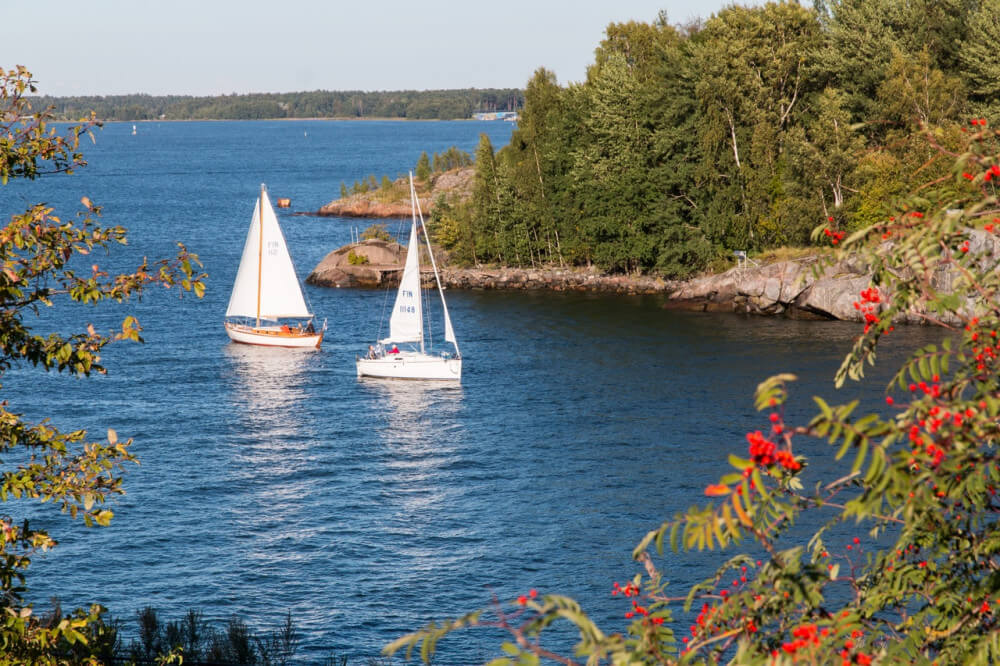
Inland sailing is definitely the best kind of sailing for beginners. You don't have to account for tides, the waves are not as high and you don't have to stock up on supplies since there's always a harbor nearby. It's also the easiest on your boat: inland waters are mostly freshwater, which means maintenance is low.
So great news for beginners on a budget: you can use any boat type: flat bottom, keel, aluminum, wood: whatever you like to sail most.
Estuary sailing
Estuary means the delta or tidal mouth of a river. It's partially enclosed water. Like inland sailing, estuary areas have a lot of oversight. With the Coast Guard keeping a close eye on everybody, the chance that something really bad happens is extremely small. You have to account for some tidal changes and the current can be strong.
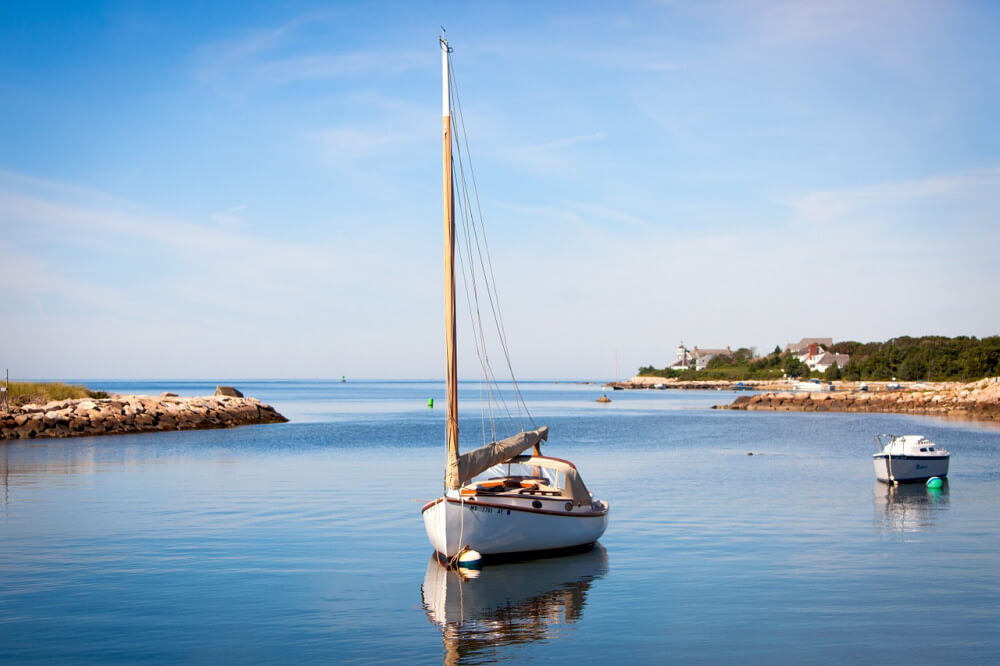
There will typically will be good weather forecasts for river deltas, so there shouldn't be a lot of sudden surprises. However, you want to be prepared in case the weather changes. Maybe you want to have a keel for this type of water, and you should definitely wear a PFD. There are some boats that have a keel you can lower if needed; this way you won't permanently increase your draft, but you'll be able to sail coastal and estuary regions.
Because river delta water is brackish, there's more salt in the water. So it's a bit harder on your boat. You probably need to increase your maintenance. Maybe you want a fiberglass hull, but you probably won't need to convert your entire boat.
Coastal sailing
Coastal sailing is a form of oceanic sailing where you're still in sight of land, but also in partially protected waters. Protected waters are sheltered waters that have stable weather conditions and have Coast Guard support. Mostly, coastal sailing requires a bit more skill and better equipment.
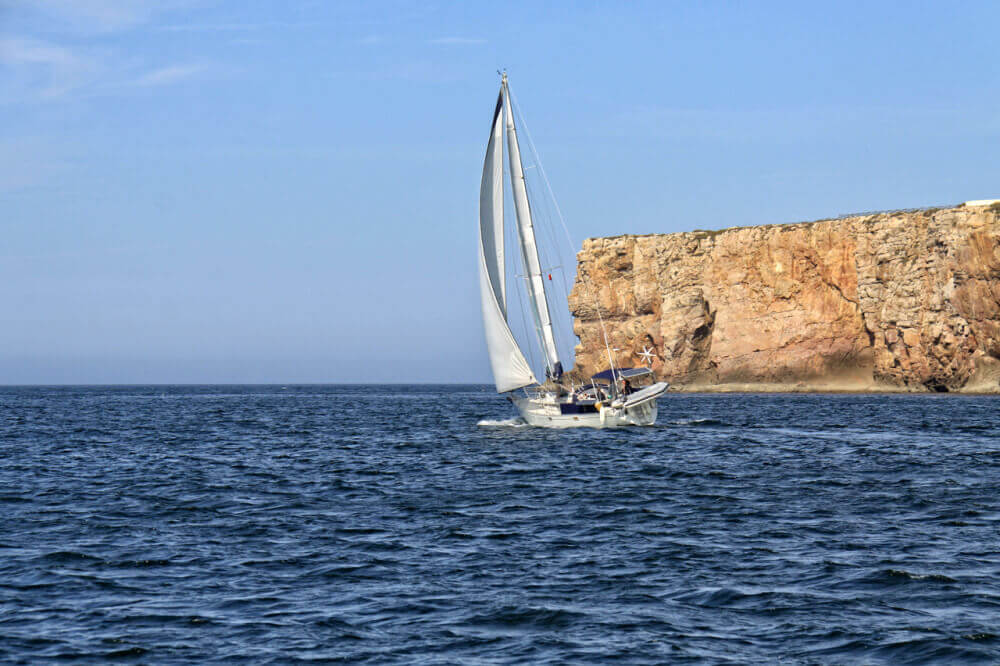
You will need a keelboat to sail coastal waters, and the hull needs to be strong enough to deal with larger waves. The forces you have to deal with are just a level up compared to freshwater conditions. If you go overboard, the consequences can be quite severe, because there can be a strong current, so make sure to wear your PFD.
But, the water is quite shallow and there are reliable weather forecasts. If you don't go out in heavy weather, you'll have enough time to get back to safe harbor when the weather starts to change.
You can use smaller sailboats without problem, but make sure the boat is safe, and you have all necessary safety equipment on board. You may also need to convert your boats engine to help it deal with galvanic corrosion.
If you want to know everything about the systems used in saltwater boats, I really recommend you read my article on boat conversion (opens in new tab).
Off Shore sailing
You're sailing off shore when you're out of sight of land, but you're not crossing an ocean. Anything under 15 miles of the coast is regarded as off shore, but if you're going out 20 miles and turning back to return for port afterwards, that's still off shore sailing and not bluewater.
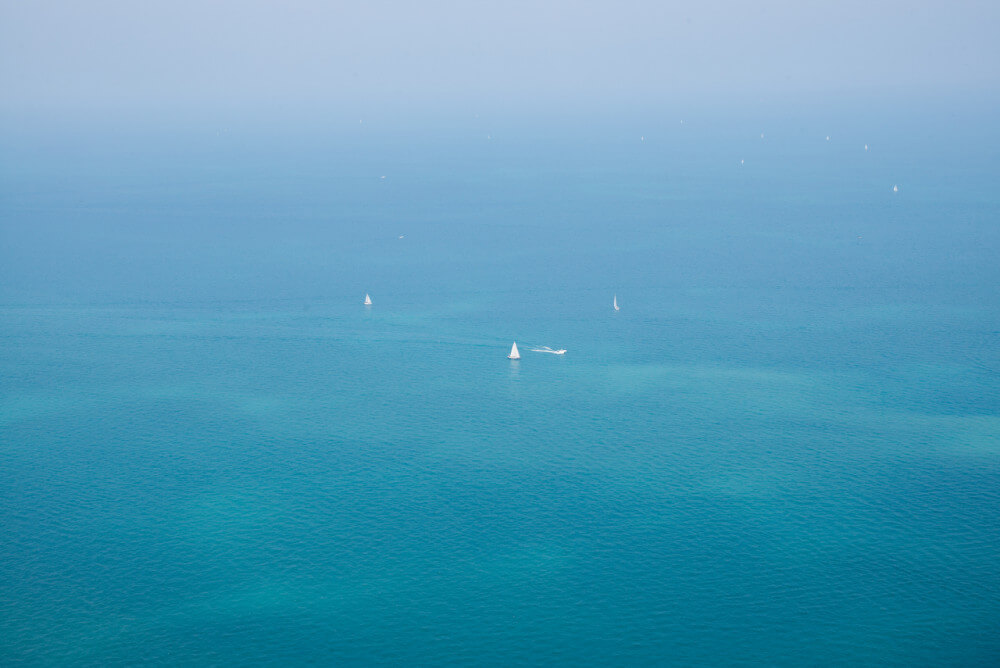
Off shore sailing can be very challenging. Sea conditions can get very rough: the weather gets more unpredictable where land meets water, and the current can get very strong. Generally off shore is more rough than open seas (except for the hurricane season). If you plan on sailing off shore, you definitely need a good strong keel boat that's a bit longer, ideally over 24 - 30 feet (7 - 9 m).
A mistake can have huge consequences. Off shore is being watched pretty closely by the Coast Guard as well, so if something goes wrong, help will be on the way. But it really makes a huge difference whether you're 12 or 20 miles out. Response time for Coast Guard is about 8 minutes at 12 miles, but it's 20 minutes at 20 miles. Drifting around in cold water for 20 minutes can be dangerous. More importantly: they have to find you out there.
So please make sure you have the right safety equipment on board. If you're unsure what you need, check out my post about USCG safety requirements here (opens a new tab).
Bluewater sailing
Blue water sailing is definitely one of the most advanced types of sailing.
Contrary to popular belief, the open seas aren't always rough. They can be, but it's mostly the off shore areas that suffer from heavy weather. Outside the hurricane season, they're mostly pretty calm. If you use the trade winds, wind conditions are pretty reliable.
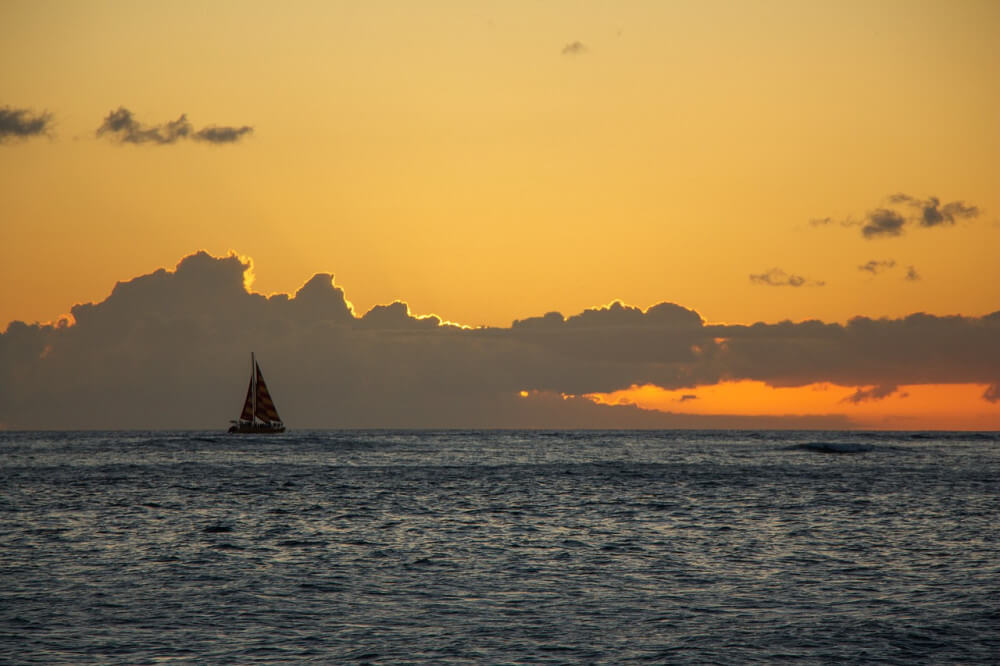
It is recommend to use a mid-sized boat (most sailors go for 30' (9 m) or up), not just for comfort but also to be able to carry enough supplies to last for at least a couple of weeks. Typically you'll need to bring roughly 40 - 60 gallons (200 - 300 liters) of water per person and 60 gallons (250 liters) of fuel.
The hardest part of bluewater sailing is being completely self reliable.
You're out on the open ocean alone, sometimes for multiple weeks on end. The Atlantic crossing takes about three weeks, for example. The longest passage there is about 12 days. During that period, if anything breaks, you need to be able to fix it. If you don't, you won't be able to continue. If something goes wrong - you get injured, for example - you're the one that needs to put on a bandage.
Some people can handle this kind of stress pretty well. Others break down because of it. It's recommended to find out what kind of person you are before getting on that boat and using the trade winds to blast it to the middle of the ocean. Where you hit a dead zone. You're now helplessly floating around in the middle of nothingness on a 100 square foot (10 square meters) piece of plastic. It's just not the best of times to meet your true self.
If you want to learn more about what it takes to do ocean crossings, consider to read my article about bluewater sailing here (opens a new tab).
More on Racing Types
Besides cruising, you can also participate in sailing races, which can be great fun. There are a lot of racing types, and you can invent your own rules and competition methods.
The type of race isn't just determined by the kind of water (like with cruising) but also the kind of event, the kind of course, and the competition method (which are the rules and requirements).
Here are the different types of racing styles:
- windward/leeward - racing course with one windward and leeward leg
- passage or course - maneuvering around multiple marks (for example buoys)
- fleet racing - the most common race form where a fleet of sailboats go around a course
- match racing - identical yachts trying to finish first in a single race
- team racing - two sailing teams with multiple boats compete to win a series of races
- one-design - competitive racing at high speeds, based on class requirements: identical models with same rigging and crew
- offshore or oceanic racing - races of multiple days or weeks in open waters over a distance of 800 miles
And this are some different types of racing events:
- twilight racing - social racing events in the summer organized by individual sailors
- club racing - social racing events organized by the local yacht club
- regatta - multiple day event with an overall event winner, typically organized by the class association
- disabled or Para World sailing - official racing events that are organized for disabled people
Competition methods
There are four primary competition methods in sailboat racing: one design and handicap.
- handicap racing - different boats, time gets corrected based on features
- one-design racing - identical boats, real time wins
- formula class - different boats with certain identical features (ie. hull speed)
- development class - different boats that meet specific requirements (ie. length, hull type, etc.)
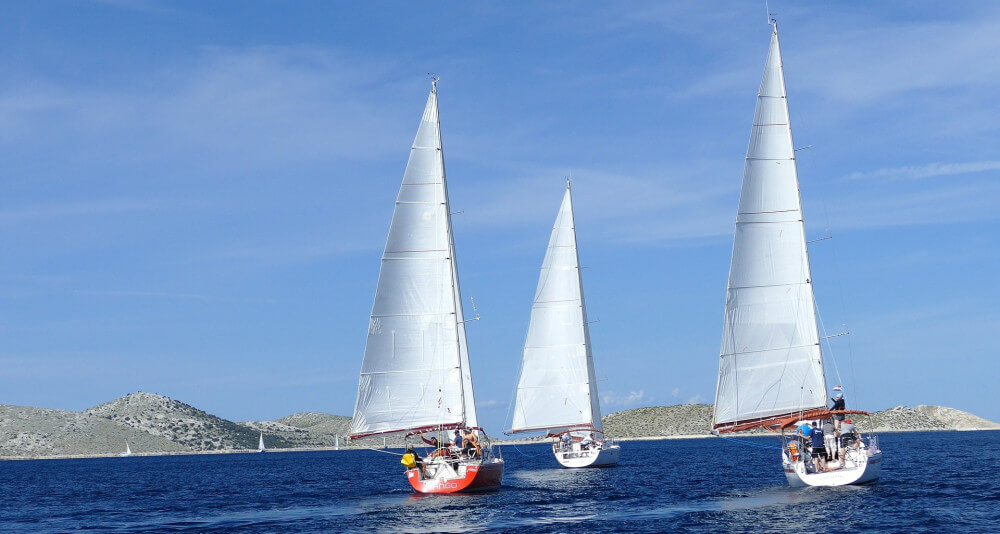
In handicap racing, time is added or subtracted based on the hull type, materials used, and other design factors. The handicap gets calculated using standardized formulas. So the winner is determined by correcting the time mathematically after the race. In these races you'll see all kinds of boat models, rigging, crews, and so on. The difference between the individual boats makes the handicap.
There are different handicap rating systems. A popular system is PHRF (Performance Handicap Racing Fleet).
In one-design racing, identical boats race for the best time. The first boat to cross the finish line wins. All boats that take part must adhere to the class requirements. So you won't see any different models or hull types in one-design racing. The class requirements determine all kinds of stuff, like the number of crew allowed, the type of rigging, amount of sails, and boat requirements.
There are a couple of other approaches. The development class is a middle way that's right in between handicap and OD racing. The boats in this class are not identical, but typically have the same length. They are all built to meet certain requirements An example is the America's Cup 12-meter.
The formula class allows different boats to compete without using a handicap system. They keep a couple of specs the same (ie. hull speed) to ensure they all have a fair chance of winning.
Related Questions
What are protected waters? Protected waters are sheltered waters that meet certain stability criteria, such as stable water conditions and emergency support by the Coast Guard. These water bodies pose no special hazards to the people sailing them. Most inland waters, like rivers and lakes, are protected waters, but also harbors and most coastal waters.
What are the most common types of racing sailboats? The most-used sailboats for racing are keel boats, centerboard boats (dinghy), multi-hulls (catamaran or trimaran), and tower ship (also called tall ships). Most keel boats are racing yachts between 24' and 50' (7 - 15 m). One of the most well-known sailboat races is the America's Cup 12-meter, which is a 40' class.
Did you find the answer to your specific question?
👍 4 👎 4
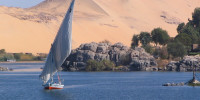
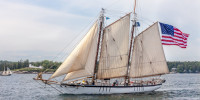
Leave a comment